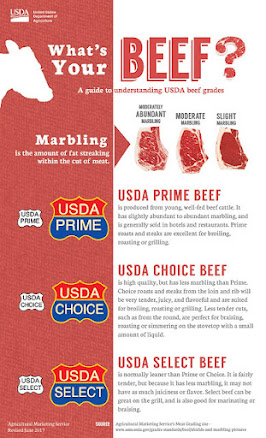Of course the price will accompany the grade. I will admit that some of the best brisket I have ever made has been from USDA Choice Grade. Enough fat, tender, and good taste.
To date there are 5 million Hereford cattle being raised in 50 countries, with 121, 000 in the U.S. alone providing 5 billion pounds of beef. Still an economic force with millions of satisfied customers.
About 100 years ago the U.S. began a swing thru the custom genetics of angus beef, black angus being the best. Angus is the name of the breed of cattle that was specifically bred from cattle indigenous of Scotland by a man named Hugh Watson in the mid-19th century. It is believed that nearly all the Black Angus cattle alive today came from the results of Watson's attempts to maximize the black hide of these animals. In the 1870s these cattle were brought to the United States and by the 1880s, the American Angus Association was founded.
There are Black and Red Angus, but the Red Angus is not recognized by the American Angus Association and is a much rarer breed. (In fact, breeders are not permitted to register their Red Angus cattle with the American Angus Association.) The Black Angus, or more commonly, Angus, is a black-hided breed without horns. The Angus breed has a number of advantages in the quality and production of the meat, and it quickly became a favored breeding stock to reduce problems of over-breeding in other lines of cattle. Because of this, it has become the most popular breed in the United States since 1978.
Retail prices for Certified Angus Beef are about 10% higher than regular USDA choice for stuff like ground chuck, and 10% to 15% higher for steaks. This is largely determined by the grades of Prime, Choice, or Select. In fact McDonalds discontinued their short experiment with Angus as not enough people were buying them and they were costing McDonald's too much to continue selling them.
There are 332, 431 registered Angus cattle in the U.S. The title will not remain forever. It is currently being challenged by Wagyu.
Wagyu literally means Japanese cattle. It is the collective name for the four principal Japanese breeds of beef cattle. All wagyu cattle derive from crossbreeding in the early twentieth century of native Japanese cattle with imported stock, mostly from Europe. Akaushi is Wagyu beef. Wagyu beef is one of the most expensive meats in the world. It features marbling, meaning that streaks of fat exist within the red meat that make it tender and moist, while adding flavor. Wagyu beef contains a higher percentage of omega-3 and omega-6 fatty acids and more monounsaturated fats than other beef. This soft fat has a low melting point and not only creates a wonderful texture but also holds most of the flavor. Prices can be steep with briskets about $10/lb, Picanha $24/lb, RibEye $50/lb, NY Strip $32/lb. It can certainly make you rethink your recipe. There are 40,000 Wagyu presently in the USA with less than 5,000 being considered 100% full blood.
The extreme marbling of Wagyu, although it is not usually what we judge the appearance of beef by, does provide superior taste as a result of the richness of the fat.
For example, Cattlemen's Ranch runs their own beef store in Sabinal, TX I have visited several times. Their breeding program is precise with a quality product. "All of our cattle are proudly born, raised, and harvested, Texas beef. We source our cattle through our family’s operation, Nunley Brothers. Through them we have Akaushi cross Santa Gertrudis cattle that help regenerate our family’s herd. Every September we hold a bred heifer sale. Each Santa Gertrudis cross Hereford heifer is bred to a black Wagyu bull. We source our second type of cattle from the calves of the customers who purchase Nunley Brothers heifers. All of our Wagyu is corn finished for a minimum of ONE year to enhance tenderness and marbling. These are non-hormone treated cattle."
About 50% of the US raised beef is exported, mostly to South and Central America as well as Mexico. Interestingly about 50% of the beef we use is also imported from these same countries. As perplexing as it sounds the reason is simple. Most the cuts popular here are not south of the border and vice versa. Demand dictates the supply. Brazil is the #1 exporter of beef in the world, although most of it goes to China.
Many TV programs featuring kitchen cooking or BBQ will mantra that 'Fat is Flavor'. Fat itself might not have a distinct taste, but it can help enhance other flavors in food. For instance, fat can absorb some flavor compounds, changing how they taste. As you chew the food, the fat releases these compounds slowly. When you cook fat, it also releases the flavor compounds that it has trapped. Much like everyone else who cooks, grills, or smokes we're all looking for that edge. That piece of meat that we love to take to the next level. Most experiment for years to find that. I know I do. This is a tutorial. Go with your own instincts. Cook it with love and your skills, you'll be happy-happy, no matter what season it is.
"A steak needs fat to taste great"
Tom Colicchio
Wi Fi provided by AT & T Wireless















No comments:
Post a Comment